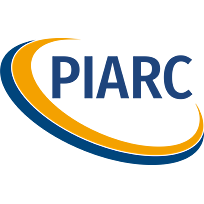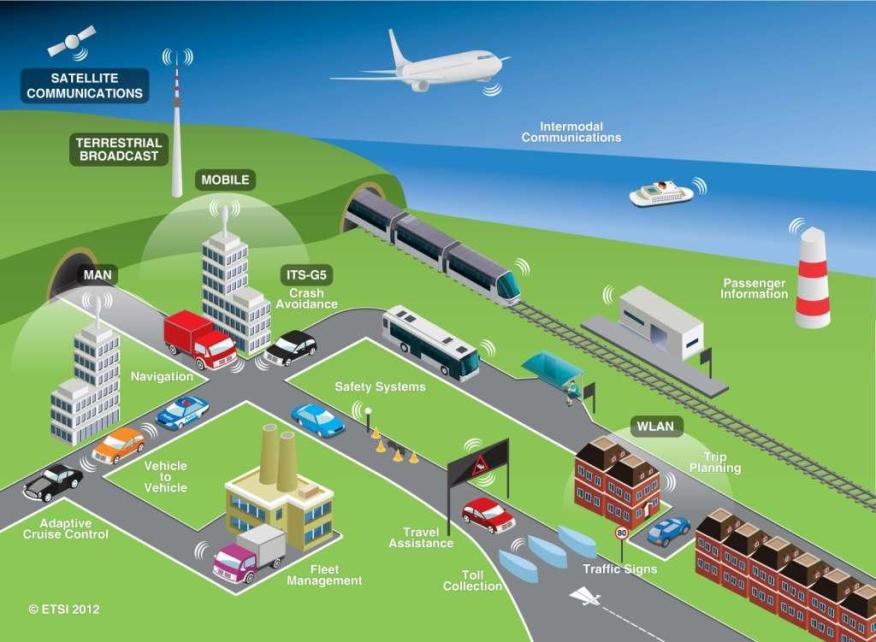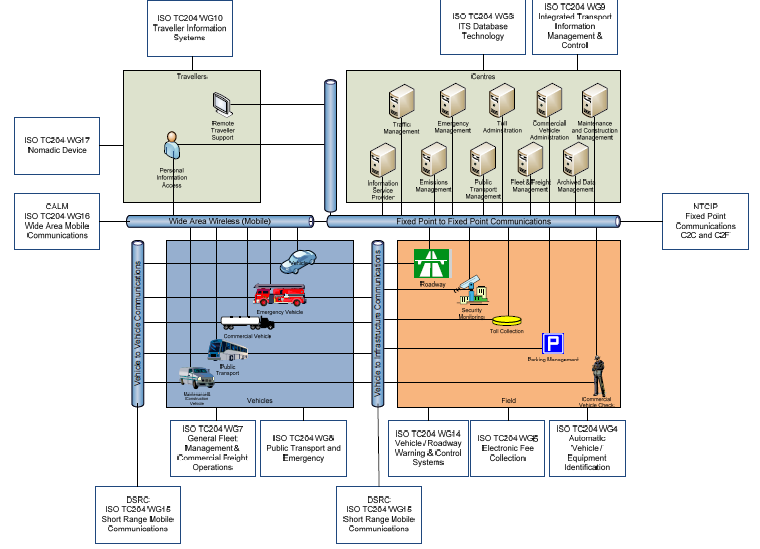

Standards have an important part to play in Road Network Operations. They are firm specifications and requirements. They ensure that systems and equipment are interoperable (sometimes with interchangeable components) – even when they are from competing vendors. A good understanding of the different types of ITS standards and their current stage of development is necessary to develop a robust ITS deployment strategy. The use of accepted standards for communications protocols and data message sets is essential, for example, when setting up data exchange arrangements between road network operators and related service providers– such as traffic management centres and traffic information providers. The standards ensure that information is correctly received and interpreted by the different software systems. (See Data Communications)
Major ITS standardisation programmes are underway in Europe, the US and Japan to address the growing need for ITS standards. They are negotiated through international standards organisations. (See Standards Organisations) These bodies have produced a broad range of standards – from traveller information to vehicle safety systems. Many standards emerge from ITS development activities - providing the basis for widespread deployment and support activities. Prototype development and field-testing help ensure that standards are fit for purpose and ready for adoption. In some cases, standards are mature enough for their use to be mandated by governments – to accelerate the deployment of ITS systems to improve mobility, safety and efficiency.
The goal of global harmonisation around standards for some ITS applications – such as satellite navigation and cooperative vehicle systems – has gained increasing support from governments and industry. A number of governments now formally coordinate their positions on standards, whilst the automotive industry has come together with digital map suppliers and mobile telecommunications and internet companies – to address the challenges of the more fast-moving technologies, such as smartphone-vehicle integration.
Changes in consumer expectations – and technical developments – create the need for standards to enable new ITS applications to be developed and deployed. Growing levels of vehicle connectivity and a focus on sustainability and “green ITS” provide opportunities for optimising transport networks. For instance, data obtained through crowd-sourcing and vehicle probes can be used by network operators and in user applications, to inform drivers about road and traffic conditions and alternative routing.
Connected vehicles demand new technical solutions, supported by standards, to ensure fast, reliable V2X communications in safety-critical situations.
V2X covers both Vehicle-to-Vehicle (V2V) and Vehicle-to-Infrastructure (V2I) telecommunications. (See Connected Vehicle Technology)
Automated vehicles rely on well-understood human interfaces and applications that can be certified as safe and reliable to operate on public highways. As transport solutions take advantage of the opportunities provided by the “Internet of Things”, more information interfaces must be managed. Examples include consumer devices such as smartphones, which interface with vehicle display systems and connect with transport information providers. (See En-route Information)
The growing body of ITS standards is a valuable resource for the increasing number of organisations deploying ITS. A review of emerging standards can also provide an insight into new industry and technology developments and trends. Standardisation may relate to some or all of a technical specification and the operational guidelines.
ITS standards will continue to evolve quickly to keep pace with new technologies and applications emerging from within and outside the transport community.
The motivation for standard setting varies. It includes securing better safety, reducing costs, and market enhancement of products. For example, for safety reasons, a driver should not be faced with complicated in-vehicle route guidance functions whilst the car is moving. To prevent this, a standard governing vehicle displays is needed to ensure a good user interface with the driver which is not distracting or confusing. (See Design of ITS for Vehicles)
For both public and private organisations involved in procuring ITS equipment, there are compelling reasons for adopting voluntary standards wherever possible:
The perspective of suppliers is less clear-cut. Depending on their market position, private companies may – or may not – be motivated to participate in standards setting by consensus. Common standards can lead to economies of scale in production – and open up sales to a wider market. Companies in dominant market positions are usually reluctant to move away from the de-facto standards of their own products – unless they are convinced that the establishment of new consensus standards would help them access a much larger market.
In general, private companies whose business is globally oriented, are interested in consensus standards and global agreement on standards – to secure economies of scale in manufacturing and marketing their products. These standards also reduce their risk of investing in new products and services that may have limited market potential – or could soon become obsolete.
The word “standard” is often misunderstood and misused. A dictionary definition of standard may refer to “a level of quality or attainment” or “falling within an accepted range”.
The official International Standards Organisation (ISO) definition of a Technology Standard is “a document that provides requirements, specifications, guidelines or characteristics that can be used consistently to ensure that materials, products, processes and services are fit for their purpose.”
Developing and adopting voluntary standards provides many benefits:
Standards can be categorised in various ways according to different perspectives that are not mutually exclusive.
ITS technical standards are concerned with how communications are adapted for a specific application – standardising specialised ITS data content and governing communications interfaces. These include protocols and message sets which enable smooth data flow and information exchange among components and subsystems:
There are some cases where ITS-specific communications standards have been developed – most notably in electronic tolling and other vehicle-to-roadside technologies. In this case, the standardisation of frequencies and modulation techniques ensures that communications hardware and software interoperate correctly. (See Standardisation & Interoperability)
Regulation can also be used to accelerate and harmonise deployment of ITS. An example of this approach is the European Commission’s ‘ITS Directive’. (See http://ec.europa.eu/transport/themes/its/road/action_plan/) It mandates that new ITS deployments in the EU comply with standards specified under the Directive – in four priority areas:
ITS standards cover a very broad range of ITS technologies, systems, services and products – ranging from map databases to vehicle control systems. Standards also have a vital part to play in the context of:

Various types of ITS rely on radio services for communication and data exchange (Image courtesy of the European Telecommunications Standards Institute - ETSI)
Two applications that are central to ITS for road network operations are the telecommunications and associated data exchange standards for ITS. Some of the applications are shown in the illustration above.
More recently, a focus on safety-related communications has led to the extension of this standards work in two areas of communication:
These standards are needed for the deployment of cooperative systems which depend on highly reliable, very low latency communication interactions (time delay) between vehicles and the roadside. For example – vehicle to roadside communications used in applications to assist in collision avoidance and traffic flow optimisation. (See Warning and Control)
As vehicle connectivity has increased, the ITS standards community has recognised the need for standardised interfaces and interactions between the vehicle and:
In the USA, a standards suite for road network operators and traffic authorities is the National Transportation Communications ITS Protocol (NTCIP). It has been updated continuously since its development in 1997. Its standards aim to facilitate data transfer:
A new set of standards which enable data transfer to and from connected vehicles and devices is being developed through a number of coordinated international efforts. (See New Forms of Mobility) For example:
The process of implementing standards within a road network operation must be approached systematically:
Step 1 – Identify – where standards should be used. It is preferable to use standardised systems wherever possible – but it may not be feasible to standardise every aspect of every system, for a variety of practical reasons such as cost, availability of appropriate solutions,
Step 2 – Determine – whether appropriate standards and examples of practice already exist. Standards development is expensive – and substantial efficiencies may be gained by learning from existing practice,
Step 3 – Assess – vendor offerings to determine standards compliance.
System architecture can be used to identify where standards are needed – now and in the future. System architecture is a conceptual framework that shows how different components in a system should fit together. It also shows the key processes which require a standardised interface – especially for communications and data exchange. The figure below illustrates this.
The ITS architecture provides the context for standards development by defining the different subsystems and the data that has to flow between them. The architecture can also help identify whether the various standards should be local, regional, national, or international. This will depend on the relevant interfaces and an analysis of operational needs, user requirements and hardware/software specifications. (See ITS Architecture)

Sample standards architecture (AustRoads)
Once the need for a standard has been identified, it is important to determine whether such a standard already exists or must be developed. Many ITS standards have already been written – and additional standards development is underway in a broad range of organisations worldwide. Research of existing standards work identifies existing standards and standards in the making. The websites of the major standards organisations provide an initial set of sources to investigate. (See Standards Organisations)
Many major standards have significant user communities that can assist new users. The relevant national or regional ITS organisation will have suitable contacts. Practitioners who have already implemented ITS standards in the field are often happy to share valuable lessons learned. Many standards development organisations have resources to help connect new users to sources of help and standards training.
The standards required may not exist. If this is the case, it is important to assess the costs and benefits of embarking on a standards development exercise with the appropriate standards development body. For a rapidly developing field such as ITS, the timing of standard setting is particularly important. Premature standards setting risk stiffling innovation.
Once standards are established, consideration needs to be given to how existing systems can migrate to the new standards over a reasonable period of time. Users who have already invested in systems are reluctant to switch to new standards before they have achieved a reasonable return on their investment. Public and private organisations need to work together to promote standards that:
It is important to recognise that products and services developed to the same standard – by different manufacturers and vendors – are not automatically guaranteed to work together properly. Interoperability failures can arise from unclear standards documentation, multiple options within a standard, or partial, rather than complete standards conformity.
One example of the interoperability challenge is the attempt to demonstrate a single vehicle’s interaction with two different European cooperative system field trials – FOTsis (http://www.fotsis.com/) and DRIVE C2X (http://www.drive-c2x.eu/project). Both prototypes were designed to be fully standards compliant – but in practice, testing showed that they were not sufficiently interoperable to allow a joint demonstration.
(See Diamandouros, K, et al., FOTSIS - European Field Operational Test on Safe, Intelligent and Sustainable Road Operation, IRF 17th World Meeting, 1 July 2013).
To avoid interoperability failures, it is critical to test standards by building prototypes – and to test finished products to see if they are truly interoperable. Some major standards bodies – such as the European Telecommunications Standards Institute (ETSI) – have programmes to do this. It is also often the case that independent companies take on this role. These procedures certify products as fully compliant with the standards cited. (See Equipment Certification)
It is important to investigate the level of standards conformity provided by a product to ensure that it will work properly with other products within the same system. In some cases, regulations may be put in place to require interoperability and standards compliance.
There are no definite answers to these questions, but it may help to:
There may be a gap in national expertise on new and evolving standards – and existing standards may not fully support local needs. Involvement in the international standards development process can help address both these issues – but it requires on-going resourcing that may not be available. It is essential to ensure access to useful resources that can help:
The Japan Society of Automotive Engineers (JSAE) publishes an annual report on current work in the International Standards Organisation’s ITS Technical Committee (ISO TC204). The 2014 report is available for download at www.jsae.or.jp/01info/its/2014_bro_e.pdf.
The JSAE website provides a listing of world standards organisations and their websites (See http://www.jsae.or.jp/index_e.php).
Standards are created at the international, regional and national levels. Stakeholders meet under the umbrella of dedicated standards bodies or organisations. Groups of committed individuals participate with the support of their companies or governments – in Working Groups that follow a formal process of development, review and ratification:
Private companies, especially those whose business is globally oriented, may be interested in consensus standards and harmonisation of global standards – to secure economies of scale in manufacturing and marketing. These standards also reduce their risk of investing in new products and services that may have limited market potential or could soon become obsolete.
In some cases, private companies may not be interested in participating in consensus standards setting. Companies in dominant market positions may be reluctant to move away from the de-facto standards of their own products – unless they are convinced that a new consensus standards will help them access a much larger market. In situations, where the social and economic benefit of having standards is high, a government initiative may be needed to secure their realisation.
Coordinated standards development is primarily handled by two types of organisations:
An industry consortium may form around a specific industry need for a standard – where the participants feel that they want to work more quickly and informally than is possible in an accredited group.
Standards developed in consortia may be submitted to an accredited body for formal standardisation. Standards developed by an individual country or region may become part of a more broadly harmonised approach – and contribute to regional or international standards setting. Some countries require adherence to standards if they have been formally approved by specific international bodies.
ITS standards have for decades been the subject of active international discussion and cooperation in organisations such as the International Standards Organisation (ISO) and the European Committee for Normalisation (CEN). Multiple stakeholders – governments, standards development organisations, and commercial entities – must reconcile their various objectives, approaches and timescales, to achieve the benefits of working together in this way.
Intergovernmental agreements have been signed between the EU, Japan, Korea and the USA to further advance cooperation between standards developers in these regions. One body arising from these agreements is the EU-US Standards Harmonisation Working Group, which has developed an action plan and other working groups to discuss:
Many other industrialised countries have also been active in coordinating their own ITS standards with international standardisation activities.
A number of organisations are engaged in setting standards at various levels around the world. In many cases, regional standards work contributes to international and global standard setting. A selection of the most significant standards bodies is below:
The ISO TC 204 overview can be found on the main ISO website. The working TC204 website is: http://www.itsa.org/industryforums/isotc204.
For background information on the work of ISO TC 204 refer to: Williams, B. (2008) Intelligent Transport Systems Standards, Artech House, Boston, London.
The UN ECE has working parties engaged in a variety of ITS areas – from driver distraction to lane departure warning systems (See http://www.unece.org/trans/theme_its.html).
The UN ECE has also developed a study of ITS deployment and best practices worldwide. Intelligent Transport Systems for Sustainable Mobility – includes a roadmap for future activities (See http://www.unece.org/trans/publications/its_sustainable_mobility.html).
CEN deals with European Standards in all domains except for electro-technical and telecommunications matters which are handled by CENELEC and ETSI.
CEN Technical Committee TC 278 on Road Transport and Traffic Telematics (established in 1991) is most involved with ITS – including those elements that need technical harmonisation for intermodal operation with other modes of transport. CEN/TC 278 cooperates with the ITS committee of the International Standards Organisation (ISO/TC 204). Cooperation is promoted by allocating a leading role – either to ISO or CEN – for each Working Group:
ETSI is a membership-based organisation that produces globally-applicable standards for Information and Communications Technologies (ICT). ITS service provision relies on communications, especially the more advanced services, making ITS an area of strategic relevance to ETSI – and one where ETSI leadership is required. (See http://portal.etsi.org/its/)